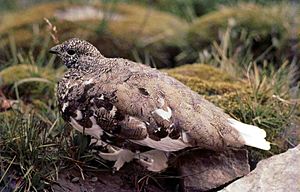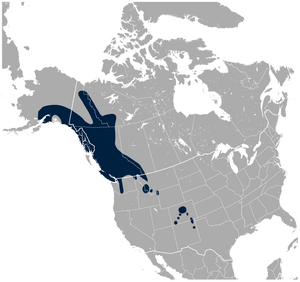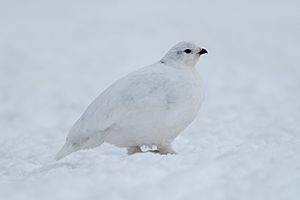White-tailed ptarmigan facts for kids
Quick facts for kids White-tailed ptarmigan |
|
|---|---|
 |
|
| Conservation status | |
| Scientific classification | |
 |
|
| White-tailed ptarmigan range | |
| Synonyms | |
|
The white-tailed ptarmigan (Lagopus leucura), also known as the snow quail, is the smallest bird in the grouse family. It lives all year in high mountains, usually above the tree line. This bird is found naturally in Alaska, Canada, and the western United States. It has also been brought to places like the Sierra Nevada in California.
The ptarmigan's feathers change color to help it hide. In summer, it has speckled gray, brown, and white feathers. In winter, it turns completely white. Its wings, belly, and tail are always white. White-tailed ptarmigans eat buds, leaves, flowers, and seeds. They make a simple nest on the ground and lay up to eight eggs. After hatching, the chicks quickly leave the nest. They first eat insects, then switch to plants like adults. Their mother uses calls to help them find food. This bird's population is stable, so it is listed as "Least Concern" by conservation groups.
Contents
About the White-tailed Ptarmigan's Name
The scientific name for the white-tailed ptarmigan is Lagopus leucura. A scientist named John Richardson first described it in 1831.
The name Lagopus comes from ancient Greek words. Lagos means "hare" and pous means "foot." This name refers to the bird's feathered legs, which look a bit like a hare's feet. The species name leucura comes from Greek words meaning "white" (leukos) and "tail" (oura). This describes the bird's tail, which stays white all year.
What Does a White-tailed Ptarmigan Look Like?
The white-tailed ptarmigan is the smallest type of ptarmigan and the smallest bird in the grouse family. It is a sturdy bird with rounded wings and a square-shaped tail. It has a small black beak and short legs covered in feathers, even down to its toes.
Adults are about 12 inches (30 to 31 cm) long. Males are only a little bigger than females. On average, they weigh about 12 to 17 ounces (330 to 480 g).
Their feathers change with the seasons:
- Summer: They are speckled grayish-brown with white underparts, tail, and wings.
- Fall: Their feathers turn more reddish-brown, and new white feathers start to grow.
- Winter: All the brown feathers are gone, and the bird is completely white.
- Spring: They molt again to get their summer feathers back before breeding.
You can tell this species apart from other ptarmigans by the fine gray patterns on its back. Both male and female ptarmigans have white tail and wing feathers all year. Males also have reddish "eyecombs," which are fleshy growths above their eyes. These are present all year too.
This bird is usually quiet. Sometimes, it makes soft, low hoots or gentle clucking sounds.
Where Do White-tailed Ptarmigans Live?
The white-tailed ptarmigan is an alpine bird. This means it lives permanently in high mountains, either above or very close to the timber line. It prefers open areas and flies more than forest grouse, but it still likes to run rather than fly.
Their home range stretches from Alaska and western Canada down to northern New Mexico. In April, males return from their winter spots to claim territories. These are usually in areas where spruce and willow trees meet the timber line. Females arrive in early May, and pairs form.
The white-tailed ptarmigan is the only bird in North America that lives in the alpine zone all year. Its habitat includes rocky areas, small twisted trees (krummholz), snowfields, and open grassy uplands. Even in winter, they stay in high valleys and mountain slopes. Here, alder, willow, birch, and spruce trees stick out through the snow.
In the 1970s, white-tailed ptarmigans were brought to the Sierra Nevada in California, the Wallowa Mountains in Oregon, and the Uinta Mountains in Utah. They might have lived there long ago but disappeared due to climate changes. Or, they might not have been able to reach these areas because of natural barriers like rivers and low-lying lands.
What Do White-tailed Ptarmigans Eat?
This bird is a herbivore, meaning it eats only plants. Its diet changes depending on the season:
- Spring: They like to eat nitrogen-rich snow buttercup leaves.
- Summer: Their diet mostly includes willow catkins, mountain avens flowers, chickweed blooms, other flowers, leaves, lichens, and berries.
- Fall and Winter: They eat pine needles, seeds, and the buds and twigs of willow and alder trees.
Winter foods have a lot of cellulose, which is hard to digest. So, the ptarmigan uses special bacteria in its cecum (a part of its digestive system) to help break down the food and get nutrients. In summer, they also eat small stones called grit to help grind up plant material.
White-tailed Ptarmigan Life Cycle
White-tailed ptarmigan males are usually monogamous, meaning they stay with one mate for a breeding season. To attract females, a male will strut around and show off his tail feathers.
The female builds a simple nest on the ground. It's a shallow dip in a snow-free spot, often protected from the wind. She lines it with grasses and a few feathers. One side of the nest usually offers a quick way to escape.
A female lays two to eight eggs. The eggs are cinnamon-colored for most of the time they are incubating. They develop brown spots when they are almost ready to hatch. The male stays near the nest until the eggs hatch, which takes about 23 days.
The young chicks are precocial, meaning they are quite developed at birth. They leave the nest just six to twelve hours after hatching. At first, they are covered in soft down feathers. They become fully fledged (able to fly) in seven to ten days.
Ptarmigan chicks start their lives by eating insects. As their digestive systems grow, their diet changes to flowers and leaves. Mother hens choose places where plants with lots of protein are growing. They call their chicks to these plants, which are very important for the chicks' growth. This shows that the mother's food calls help the young ptarmigans survive. The young birds stay with their mother throughout the summer and autumn.
How White-tailed Ptarmigans Survive
The white-tailed ptarmigan is very good at hiding on the ground. Its feathers provide amazing camouflage, helping it blend in with its surroundings. This helps them avoid being caught by golden eagles or other birds of prey.
These birds have feathers on their feet. These feathers protect them from the extreme cold found in their mountain home. They also have feathers around their nostrils. These feathers help warm the air before it enters their lungs. To save energy during cold winter months, ptarmigans fly as little as possible. They also rest in snowbanks, which act like insulation.
The white-tailed ptarmigan is listed as "Least Concern" by the International Union for Conservation of Nature. This means they are not currently in danger. Even though their numbers might be slightly decreasing in some areas, they live across a very wide range, and there are many birds in total.
This bird is also an "indicator species" for the alpine tundra. This means its health can show how healthy the whole mountain ecosystem is. Since the white-tailed ptarmigan is doing well, it suggests that this region is not having big changes in climate or temperature. Also, there isn't much cattle grazing or human development in these high mountain areas. It's also hard for people to reach their remote homes. Laws about hunting limits also help the white-tailed ptarmigan thrive.
Images for kids
See also
 In Spanish: Lagópodo coliblanco para niños
In Spanish: Lagópodo coliblanco para niños






